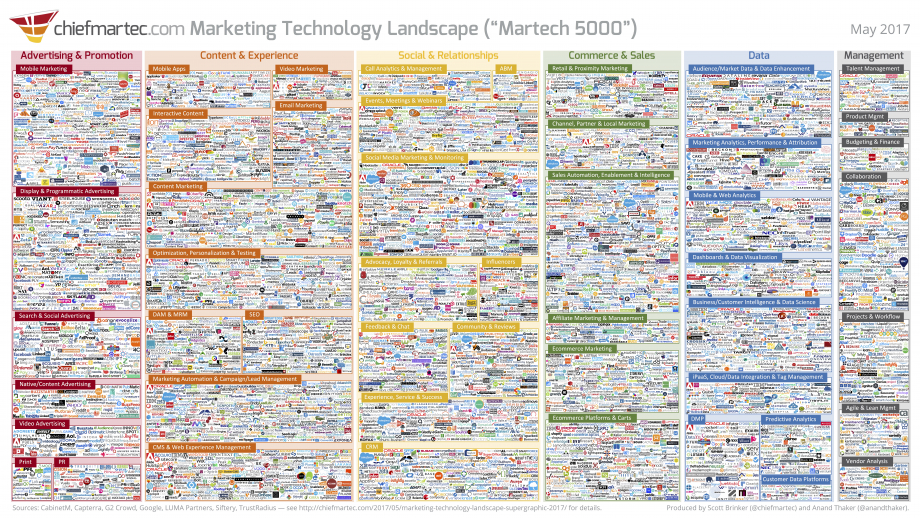-
No-Code
Platform
-
Studio
No-code agentic platform delivering the fastest time-to-value and the highest ROI
-
Studio
-
AI-Native CRM
CRM
-
AI-Native CRM
New era CRM to manage customer & operational workflows
CRM Products -
AI-Native CRM
- Industries
- Customers
- Partners
- About
The challenges of modern marketers
08/24/2017
3 min read
Remember when marketers used one or two key applications? Neither do I, but in the event that you have been hiding somewhere, 2017 is the year Gartner predicts CMO spending will finally pass CIO spending on technology. This is a huge milestone, but before you get tempted to run out and start a marketing technology company to cash in or pivot your sales focus to the CMO, you might want to take a long, intense look at the marketing technology space to better understand what the day in the life of a current marketer has become.
5000+ Vendors
Thousands of tech companies have created products to help CMO's spend those booming budgets, with some incredibly cool solutions that can help marketers track, manage and crunch data, automate marketing processes and customer engagement, and streamline marketing across communication channels. In fact, over 5000 companies are competing for CMO wallets.
These are just a few among dozens of marketing tech categories. It’s an exciting time to be a marketer or sales-person using technology, but unfortunately not everyone fully understands this modern revenue technology environment and what marketing (and sales) teams have to deal with when choosing to deploy new technology.
Stacking
Marketing departments use a "stack" of technologies to power every step of the customer or marketer journey. In fact, according to Kleiner Perkins, the average number of cloud applications in the marketing department is 91. While this may sound more like a massive Jenga tower than a "stack", this is the new.
What is confusing to both marketing departments and the sales team of most of the vendors in the massive graphic above is the amount of overlap with many of these technologies. Mailchimp, Sendgrid, ExactTarget, and bpm'online all have email delivery features, but none are really competitors. The life of a marketer evaluating new technology is difficult, so the following are 3 guides that should help anyone seeking to engage a marketing department talk about software.
Play well with others
Technology stacks are the new normal, and every marketing technology needs to play well with others. Just because a company has somewhat competitive features doesn't mean they are actually competing and even if they are, be ready to walk away from deals if you don't integrate. With an average of 91 technologies in the enterprise marketers stack, overlap is inevitable. It doesn't require 91 products in a stack to find overlap. Mention, a tech company that allows you to monitor your brand online has roughly 30 products in their stack (according to Stacklist) and yet they list 3 different products that send email as a primary function - Mailjet, Hubspot, and Customer.io. While email might be the most obvious, it doesn't compare to analytics. Mention's stack includes 12 products with analytics, and at least 5 for whom analytics is a major feature.
Marketers aren't all-seeing, all-knowing
Having looked at plenty of software usage analytics over the last 15 years, I can tell you that most products are underused. The average user consumes about 35% of the value of any one application that they are actively using. Don't expect the typical marketer to immediately grasp the incredible genius of your product and instantly see all the potential use cases. With so many options, companies need to be able to clearly (and quickly) articulate how the end-user is going to get value from the technology, and how the technology fits within their existing stack. Teams are becoming more and more forthcoming with their tech stacks when evaluating new technology because they need the vendor to help them understand how it fits. This is especially critical because of the feature overlap in so many products. As a technology vendor, it's never been more critical to understand your unique differentiators and be able to succinctly explain them. Leave this up to the buyer at your own peril.
Code kills all deals
The fastest way to end the discussion is require the marketing team to have to touch code. In some cases, this is inevitable - many products need javascript added to a website, or html added to a template - but understand the environment these marketers are dealing with. Ten years ago marketing projects were held up by IT/development backlogs, so marketers demanded that software providers simplify the code requirements and products like tag managers and single-snippet code deployments became standard operating procedure. Optimizely gained massive market penetration by giving marketers a way to easily deploy and test new content without having to touch the code on the website each time. More advanced products existed, but marketers chose ease-of-use over power and Optimizely became a billion dollar company. Solutions like Coupler.io allow marketers to easily set up integrations to collect data from varying sources in one destination without coding required.
There are exceptions of course, but understanding and optimizing for these three concepts will help marketers significantly and improve the lives of companies creating products for them.





















































